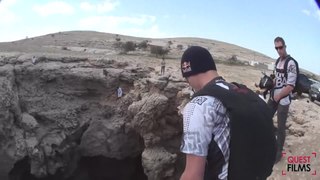
BASE jumping is the recreational sport of jumping from fixed objects, using a parachute to descend to the ground. BASE is an acronym that stands for four categories of fixed objects from which one can jump: buildings, antennas, spans (bridges) and earth (cliffs). Participants jump from a fixed object such as a cliff and after an optional freefall delay deploy a parachute to slow their descent and land. A popular form of BASE jumping is wingsuit BASE jumping.

A parachute is a device used to slow the motion of an object through an atmosphere by creating drag or aerodynamic lift. A major application is to support people, for recreation or as a safety device for aviators, who can exit from an aircraft at height and descend safely to earth.

The Rogallo wing is a flexible type of wing. In 1948, Francis Rogallo, a NASA engineer, and his wife Gertrude Rogallo, invented a self-inflating flexible wing they called the Parawing, also known after them as the "Rogallo Wing" and flexible wing. NASA considered Rogallo's flexible wing as an alternative recovery system for the Mercury and Gemini space capsules, and for possible use in other spacecraft landings, but the idea was dropped from Gemini in 1964 in favor of conventional parachutes.

A drogue parachute, also called drag chute, is a parachute designed for deployment from a rapidly moving object. It can be used for various purposes, such as to decrease speed, to provide control and stability, as a pilot parachute to deploy a larger parachute or a combination of these. Vehicles that have used drogue parachutes include multistage parachutes, aircraft, and spacecraft recovery systems.

A drogue or storm drogue is a device trailed behind a boat on a long line attached to the stern. A drogue is used to slow the boat down in a storm and to prevent the hull from becoming side-on to the waves. A boat that has deployed a drogue should not overspeed down the slope of a wave and crash into the next one, nor will the vessel broach. By slowing the vessel, the drogue makes the vessel easier to control in heavy weather and will help to prevent pitchpoling.
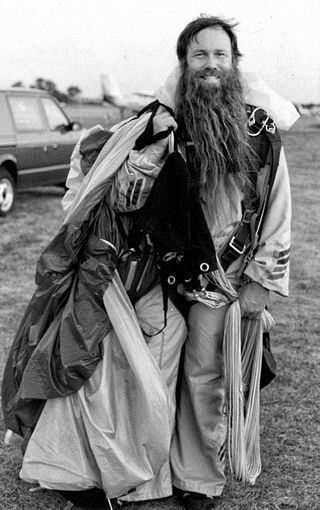
Bill Booth is an American engineer, inventor, and entrepreneur in the skydiving equipment manufacturing industry. His invention of the 3-ring release safety device has enhanced skydiving safety. He founded the companies United Parachute Technologies and Complete Parachute Solutions, which had 150 employees as of 2015.

In skydiving, an automatic activation device (AAD) is a dead man's switch consisting of an electronic-pyrotechnic or mechanical device that automatically activates the opening sequence of the main or reserve parachute container when the AAD is falling below a preset altitude and above a preset decent speed.

A malfunction is a partial or total failure of a parachuting device to operate as intended. Malfunctions may require a skydiver to cut away their main parachute and deploy the reserve parachute.

A static line is a fixed cord attached to a large, stable object. It is used to open parachutes automatically for paratroopers and novice parachutists.

A reserve static line, occasionally called a Stevens Lanyard or Stevens Release, is a device that automatically opens the reserve parachute container when the main parachute is cut-away. The RSL is a lanyard connecting one or both of the main parachute risers to the reserve ripcord.

Leslie Leroy Irvin was a stunt-man for the fledgling Californian film industry. Flying in balloons, he performed using trapeze acrobatics and parachute descents. For the 1914 film Sky High, Irvin made his first jump out of an airplane while flying at 1,000 feet above the ground. In 1918, he developed his own life-saving static line parachute, jumping with it several times and promoting it to the US Army. Irvin joined the Army Air Service's parachute research team at McCook Field near Dayton, Ohio where he made the first premeditated free-fall jump with the modern parachute on April 28, 1919.

The low-altitude parachute-extraction system (LAPES) / Low-level parachute extraction resupply system (LOLEX) is a tactical military airlift delivery method where a fixed-wing cargo aircraft can deposit supplies in situations in which landing is not an option, in an area that is too small to accurately parachute supplies from a high altitude. This practice is no longer used in the USAF.
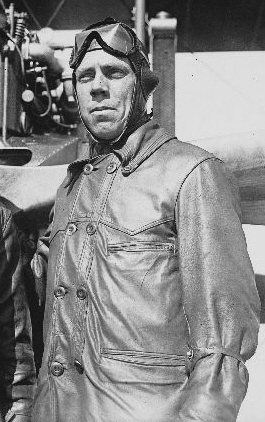
James Floyd Smith was an inventor, aviation pioneer, and parachute manufacturer. With borrowed money, he built, then taught himself to fly his own airplane.
RAPS or Ram Air Progression System is a parachuting training system designed to take a student from beginner to the FAI A License using square ram air canopies.

Ripcord was an American syndicated television series starring Larry Pennell, with Ken Curtis, which ran for a total of 76 episodes from 1961 to 1963 about the exploits of a skydiving operation of its namesake.
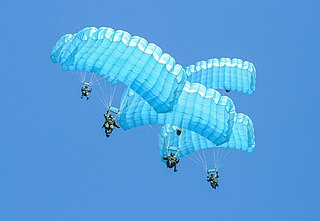
Parachuting and skydiving are methods of descending from a high point in an atmosphere to the ground or ocean surface with the aid of gravity, involving the control of speed during the descent using a parachute or multiple parachutes.
A ripcord is a part of a skydiving harness-container system; a handle attached to a steel cable ending in a closing pin. The pin keeps the container closed and keeps the spring-loaded pilot chute inside. When the ripcord is pulled, the container is opened and the pilot chute is released, opening the parachute. On tandem systems the ripcord releases the 3-ring release system anchoring the bridle to the harness-container, allowing the parachute to open.
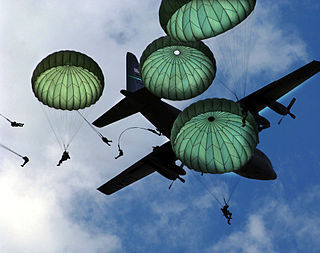
The T-10 Parachute is a series of static line-deployed parachutes used by the militaries for combat mass-assault airborne operations and training. The T-10 parachute was introduced in the early 1950s. In 1976, the B model introduced the anti-inversion net; in 1986, the C model was introduced, which changed the pocket band free length from 4" to 7½". The T-10D, adopted in 2000, includes the detachable pack tray, which in itself includes the 15' universal static line and 5' extension static line. The T-10D is currently being replaced by the T-11 parachute system. In 2006, all T-10C parachutes were revised by adding one static line stow bar to each side of the pack tray; the material for the T-10C was also changed to the Army's Foliage Green #504.
A closing pin is a curved piece of stainless steel metal used in the sport of skydiving. The pin is sewn onto the bridle, which is a 7- to 10-foot-long piece of nylon webbing connected to the pilot chute. The closing pin passes through the closing loop and in doing so, secures the main container of a skydiving rig, keeping the parachute from deploying prematurely. When the pilot chute is thrown out by the skydiver and catches air, it pulls the closing pin from the closing loop and allows the main parachute to be released from the container and inflate.
A main assisted reserve deployment (MARD) system is a skydiving safety device for parachute systems. While there are many variations, the operation and intended outcome for each is the same: open the reserve parachute container and extract the reserve parachute's deployment bag using the jettisoned main canopy. A MARD builds upon how a reserve static line (RSL) safety device works and in most circumstances, MARDs incorporate an RSL.

















